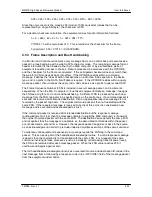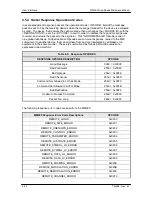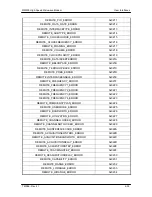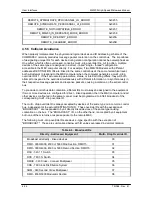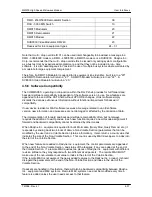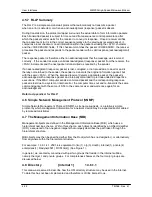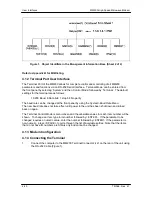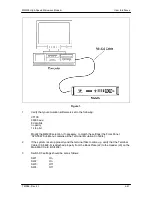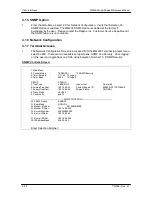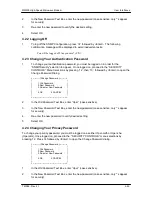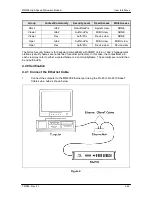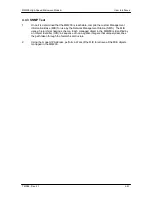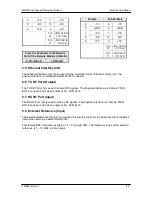
MM200 High-Speed Microwave Modem
User Interfaces
TM086 - Rev. 4.1
4-47
This section refers to the Boot Host.
1.
Select 36, ‘Server Host Name’. Enter the Server Host Name and press <Enter>. This is
a descriptive entry only.
Example: SERVER
4.30 Router IP Address
Select 37, ‘Router IP Addr’. Enter the router Internet Address in dot notation and press <Enter>.
Please consult your network administrator for valid addresses.
Example: 192.168.0.254
4.31 IP Address Mask
In the mask (more clearly seen in the binary format), binary 1s indicate the position of the network
and subnet portion of the IP Address while binary 0s identify bits that represent the individual
interfaces. To recognize a subnet, each system in the subnet must have the same subnet mask.
Please consult your network administrator for a valid address class mask.
1.
Select 38, ‘IP Address Mask’. Enter the IP Address mask in dot notation and press
<Enter>.
Example: 255.255.0.0
4.32 Boot Mode (Optional)
1.
Select ‘31’ from the Controls Menu and press <Enter>. Scroll through the various
selections to ‘NVBOOT’ and press <Enter>. The above settings will be enabled the next
time the system is rebooted. If a bootp server is available, the MM200 can be remotely
configured by selecting bootp mode. This option is currently not available.
4.33 Community
Each managed station controls its own local MIB and must be able to control the use of that MIB
by a number of management stations. This relates to security concerns. A managed MIB such
as the MM200 needs to protect itself from unwanted and unauthorized access. SNMP, as defined
in RFC 1157, provides only a limited capability for such security, namely the concept of a
community. An SNMP Community is the relationship between an SNMP Agent and Management
Stations.
1.
To set the community string on the MM200, select 9, ‘Community’. Enter the desired
community name and press <Enter>.
Example: “public”
4.34 Trap Type and Trap Hosts
Traps enable the modem to notify the management station of significant events such as alarms.
Version1 and version2 Traps are supported at this time. These are Operator selectable using
Terminal Command Number 5. The messages are sent to specific pre-defined hosts. The
Primary and Secondary Trap Hosts IP Addresses are setup using Terminal Commands 6 and 7.
Each host should be acceptable to the transport layer. In other words, the transport layer needs to
be able to open a connection to the entities specified by the trap host fields.
Summary of Contents for MM200
Page 2: ......
Page 14: ...Introduction MM200 High Speed Microwave Modem 1 2 TM086 Rev 4 1...
Page 18: ...Installation MM200 High Speed Microwave Modem 2 2 TM086 Rev 4 1...
Page 24: ...Theory of Operation MM200 High Speed Microwave Modem 3 6 TM086 Rev 4 1...
Page 76: ...User Interfaces MM200 High Speed Microwave Modem 4 52 TM086 Rev 4 1...
Page 93: ...MM200 High Speed Microwave Modem Electrical Interfaces TM086 Rev 4 1 5 17...
Page 96: ...Troubleshooting and Maintenance MM200 High Speed Microwave Modem 6 4 TM086 Rev 4 1...
Page 99: ...Technical Specifications MM200 High Speed Microwave Modem 7 2 TM086 Rev 4 1...
Page 100: ......
Page 147: ...MM200 High Speed Microwave Modem Appendix A TM086 Rev 4 1 A 47...
Page 148: ......
Page 186: ...Appendix B MM200 High Speed Microwave Modem B 38 TM086 Rev 4 1...
Page 192: ...Glossary MM200 High Speed Microwave Modem G 6 TM086 Rev 4 1...

